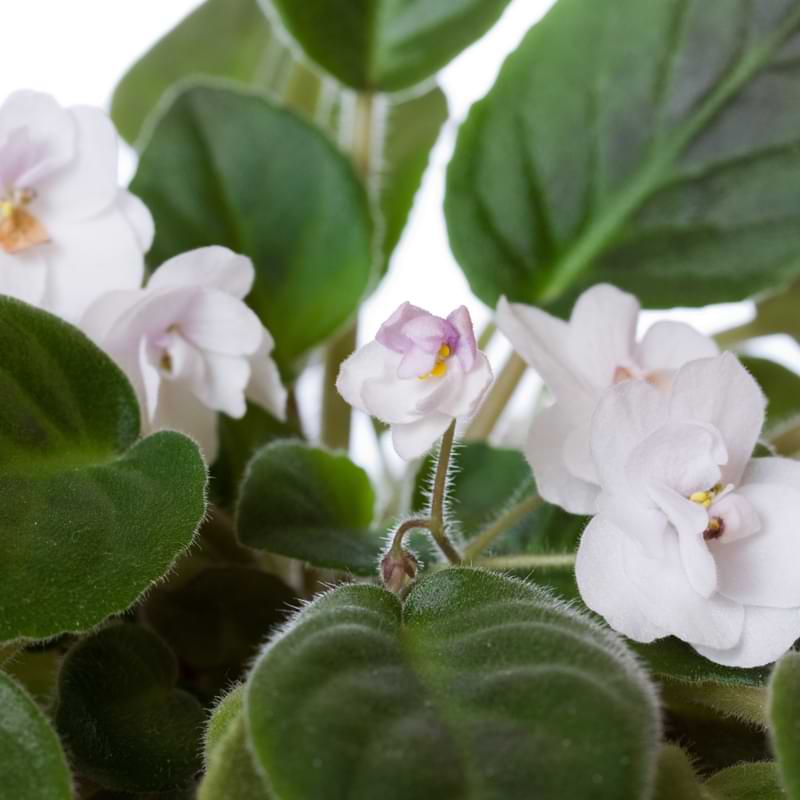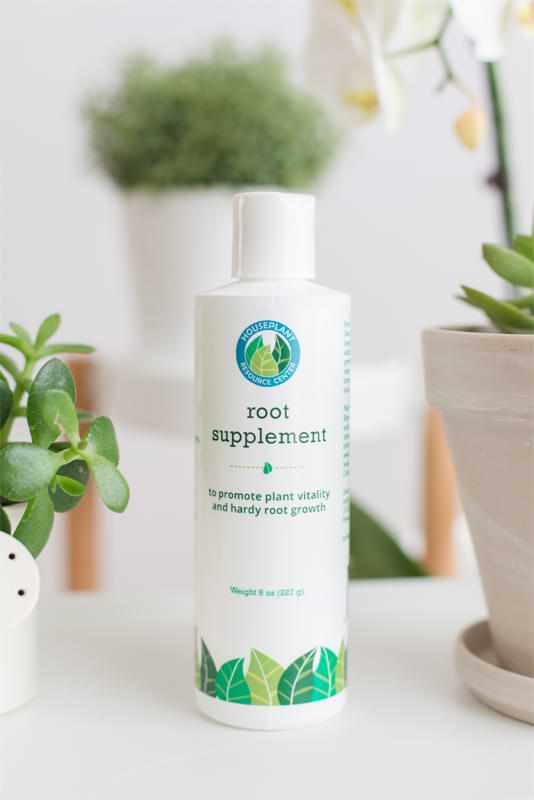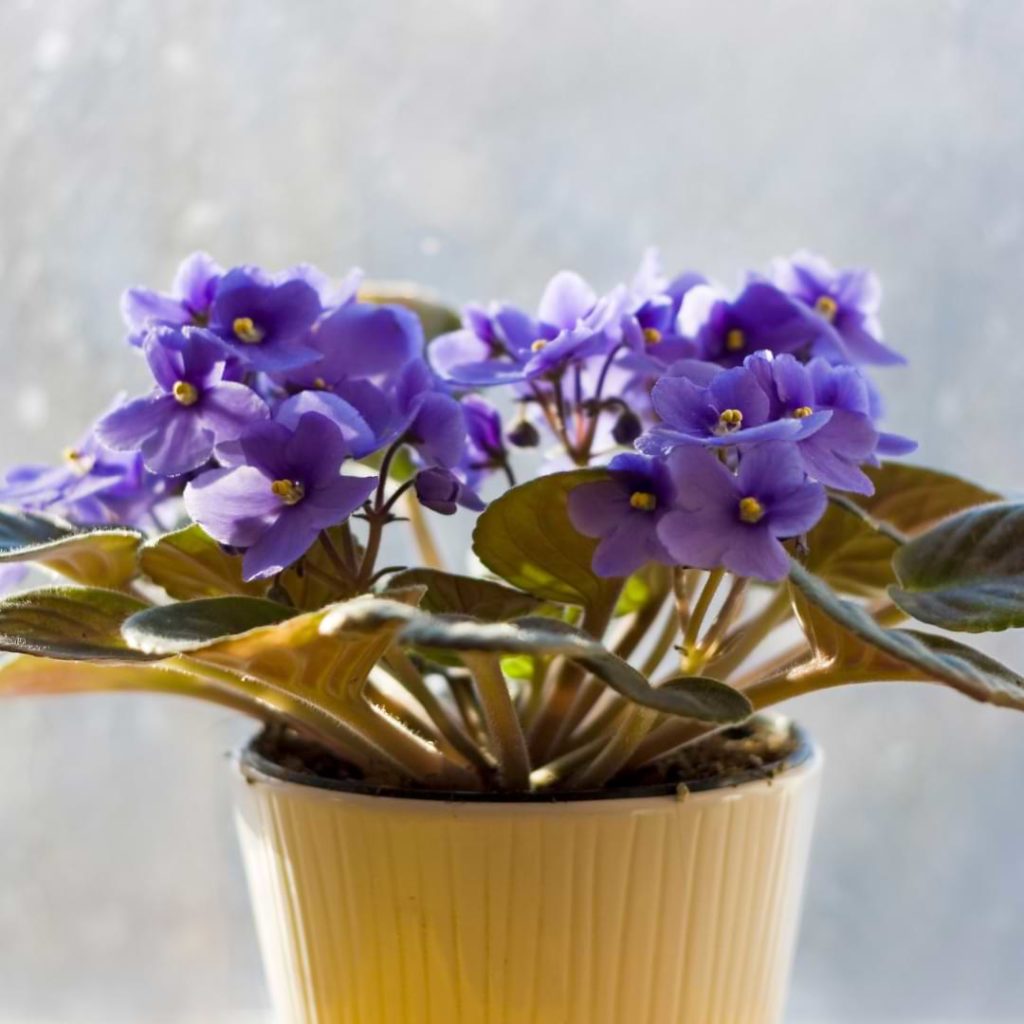African violets are popular houseplants that are easy to take care of and relatively hardy while still looking beautiful. However, they can fall prey to a few different diseases. The most common disease African violets face is root rot, which can quickly turn a thriving African violet into a sad, wilted plant
While most African violets don’t develop root rot, the disease can cause an African violet to die if not treated soon enough. The good news is that root rot is fairly easy to prevent as long as you know what to do.
If you aren’t able to prevent root rot, don’t panic. Root rot is also not too difficult to treat as long as you begin treating it in time.
Keep reading to find out how to identify root rot, how to treat it, and how to prevent it from occurring in the first place.
Identifying African Violet Root vs. Stem Rot
Root rot and stem rot can appear similar in African violets. In the early stages, both root rot and stem rot can result in the leaves becoming pale and plant growth slowing down. However, if you look closely, it’s possible to distinguish root rot from stem rot. Since African violets are more likely to recover from root rot than from stem rot, it’s important to figure out which disease is attacking your African violet.
Both diseases are caused by fungus, and both can kill an African violet. It’s important to be able to identify which problem your African violet has.
Here’s what to look for when you notice something “off” about your African violet.
What Does Root Rot Look Like?
Root rot, which is caused by the fungus Cylindrocarpon, starts in the roots. Root rot has time to progress before symptoms become visible in the foliage. Even though it’s unlikely you’ll notice the roots at first, they will begin to turn yellow and decay.
It’s more likely you’ll notice symptoms above the soil line before you notice the damage to the roots. In the beginning stages of root rot, an African violet’s leaves will lose color, appearing yellow or gray. As the disease worsens, the leaves will begin turning black or brown. The leaves will also begin to wilt and feel jelly-like to the touch.
Unlike other types of rot in African violets, it’s possible to treat root rot. If you catch root rot soon enough, your African violet has a good chance of recovering.
What Does Stem Rot Look Like?
Stem rot, which is caused by the fungus Pythium, attacks both the root and crown of African violets while also causing the stem to rot at the base.
Although the leaves will lighten at first just like with root rot, grayish leaves rather than yellowish leaves are a sign of stem rot. In fact, it’s possible that the leaves will barely change in appearance. The stems will wilt or turn mushy at the base, though, and the stems may be unable to hold up the leaves.
Unfortunately, stem rot is usually fatal for African violets. While there is an intensive remedy you can try with infected African violets, it’s usually better to get rid of an infected plant right away rather than attempting to treat the stem rot for weeks before having to get rid of it.
Crown Rot
Another type of rot that affects African violets is crown rot. This disease is caused by the fungus Phytophthora, starts by attacking the roots first, and becomes most visible in the crown.
Generally, you can distinguish this type of rot because the crown is mushy and dark. You may also notice other signs like a weblike substance on the crown and leaves.
Once again, crown rot is usually fatal for African violets. There is an intensive remedy you can try on African violets with crown rot, but it’s not likely to be successful. Throwing away the infected plant as soon as you notice crown rot tends to be the best idea.


Causes of Root Rot in African Violets
Root rot is caused by a fungus, but certain conditions allow the fungus to develop and affect your African violets. Being aware of the conditions that cause root rot will allow you to better prevent root rot from occurring in the first place. Even though root rot in African violets can usually be successfully treated, it’s much less work to prevent the problem before it starts.
Watering Issues
The most common issue leading to root rot is watering. An overwatered African violet is more likely to develop root rot because fungus develops more quickly in a wet, soggy environment.
Don’t water your African violet more often than it needs to be watered, and make sure that whatever container you use for your African violet has adequate drainage to allow excess water to escape. Allow the soil to almost dry out before watering again. Using a moisture meter can take the guesswork out of when to water.
While you don’t want to underwater your African violets either, underwatering takes much longer to have a negative effect on African violets. They’ll be fine if you accidentally go an extra day or two without watering.
Some of the symptoms of root rot, like the leaves turning yellow, are also symptoms of lack of water. Some people assume that their African violets affected by root rot need more water and make the problem even worse. Always check to see how dry the soil is before watering. If your African violet has yellow leaves but the soil is still wet, don’t water it.
Soil Conditions
The soil also plays a role in creating the wet, soggy environment that allows root rot to develop. Soil used for African violets needs to be quick-draining. Most regular potting soil is too dense and holds on to too much moisture.
For this reason, we recommend using potting soil designed specifically for African violets. An African violet soil mix is typically lighter and allows water to move away from the roots quickly. Since African violets are so popular, it’s easy to find soil designed just for them.
Temperature Changes
Drastic changes in temperature can play a role in the development of root rot as well. If the temperature is too cold or too hot, this can damage your African violet, including the roots. Plants that are damaged are more prone to disease than healthy African violets.
Stress
Since stress weakens your African violet, it can contribute to root rot as well. Try to keep conditions as consistent as possible to keep damage from occurring to your African violet’s roots. A healthy plant is less likely to develop diseases.
How to Fix Root Rot
Unlike some other forms of rot, African violets can sometimes recover from root rot. Although you can’t fix roots that have already rotted, if enough healthy roots remain, you have a good chance of being able to save the plant.
If you catch root rot early enough, your plant can recover. Follow these steps to treat root rot in your African violet and prevent root rot from occurring again.
Repotting
Since fungus in the soil causes root rot, you’ll need to repot an infected African violet in new soil to save it. Be sure to use soil that drains well; soil mix designed for African violets is best. Regular potting soil will hold on to too much water and your African violet’s roots will probably not be able to recover.
You’ll likely need a new container when you repot. Since you’ll be removing any infected roots, your African violet probably will need a smaller container than it did before. You can reuse the old container for another plant later on, but the container must be thoroughly cleaned and disinfected to prevent fungus from developing in the soil with the next plant.
Removing Affected Areas
Before placing the African violet with root rot in a new container, you need to remove any damaged roots. Healthy roots look gray or white and feel firm, while damaged roots look dark brown and feel soft.
An African violet can usually survive as long as no more than ⅔ of the roots are removed. If you see that you need to remove more than this amount, your African violet is unlikely to be able to survive. While it’s disappointing to lose an African violet to root rot, it does happen sometimes.
If you need to remove more than ⅓ of the roots due to damage, you will also need to remove the bottom row or two of the leaves; otherwise, the small root system may not be able to provide enough nutrients and water for the rest of the plant while also recovering.


Preventing Further Issues
As your African violet recovers, make sure you don’t overwater or allow water to pool up in the plant’s container. Wait until the soil is almost dry before watering again. Providing good care will help your African violet recover and prevent root rot from occurring in the future. Treat with a Root Supplement to continue treating the root infection and prevent it from happening again.
It’s also important to repot your African violet at least once a year. During this time, you’ll refresh the soil, which allows your African violet access to more nutrients. Repotting does place stress on your African violet, but it’s necessary for your plant to continue thriving. Regarding root rot, repotting is the perfect time to check for damage to the roots. Removing damaged roots and refreshing the soil will keep the soil from allowing the fungus that causes root rot to form.
For more information about caring for your African violet, see our guide How to Care for African Violets.
African Violet Root Rot FAQ
Still have questions about root rot in African violets? Here are a few concerns people tend to have when it comes to African violets and root rot.
Can root rot be reversed?
While you can’t reverse the damage of rot in roots that have already been infected, you can prevent root rot from spreading to other roots and save your African violet. Remove any damaged roots and repot your African violet in a new container with fresh potting soil.
Can root rot repair itself?
Root rot will not go away on its own. If you allow the rot to spread, the damage will eventually kill the African violet. However, you can take steps to remove the damaged roots and prevent root rot from spreading, which will also give your African violet a chance to recover.
How do I know if my African violet has root rot?
To see if an African violet has root rot, take a look at the roots. Decayed roots will be brown or black and feel mushy. Healthy roots will be gray or white and feel firm when touched.
How often should African violets be watered?
The exact timing for watering African violets differs depending on several factors. The best way to know it’s time to water your African violet is to check the soil. If the top inch or two of soil is dry, it’s time to water. In general, expect to water about once a week, but adjust as needed based on what you observe with your plants.
Join the African Violet Club!
Whether you’re just starting out or are a seasoned grower, African Violet Resource Center has everything you need to help your plant grow vibrant and strong. Explore our other articles, visit our online shop, and connect with other houseplant lovers in our Facebook group to learn everything you need to know about this rewarding hobby!
More Great African Violet Resources
African Violet Diseases & Fungus | Causes and How to Fix
A Beginner’s Guide to African Violet Houseplants





